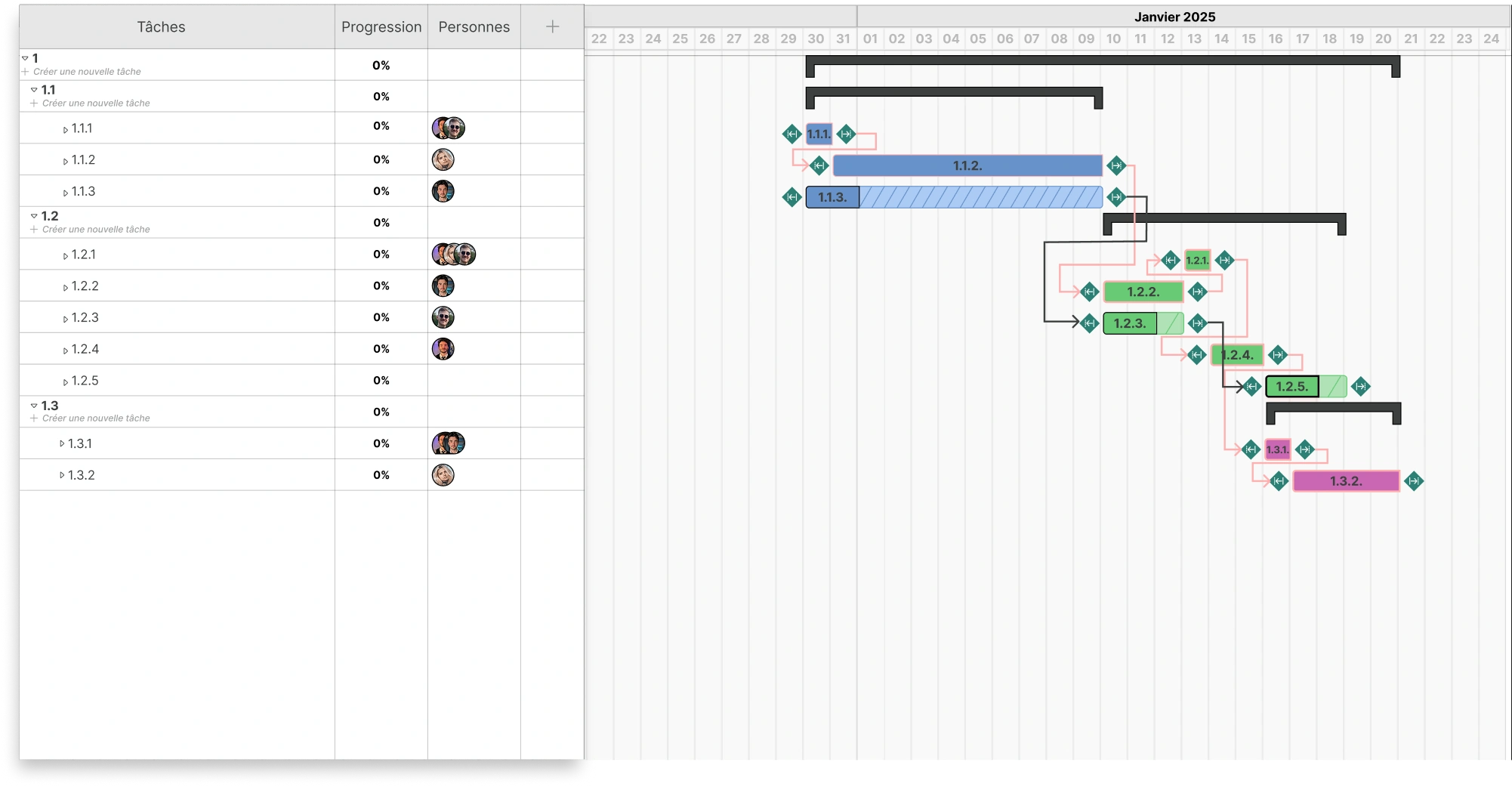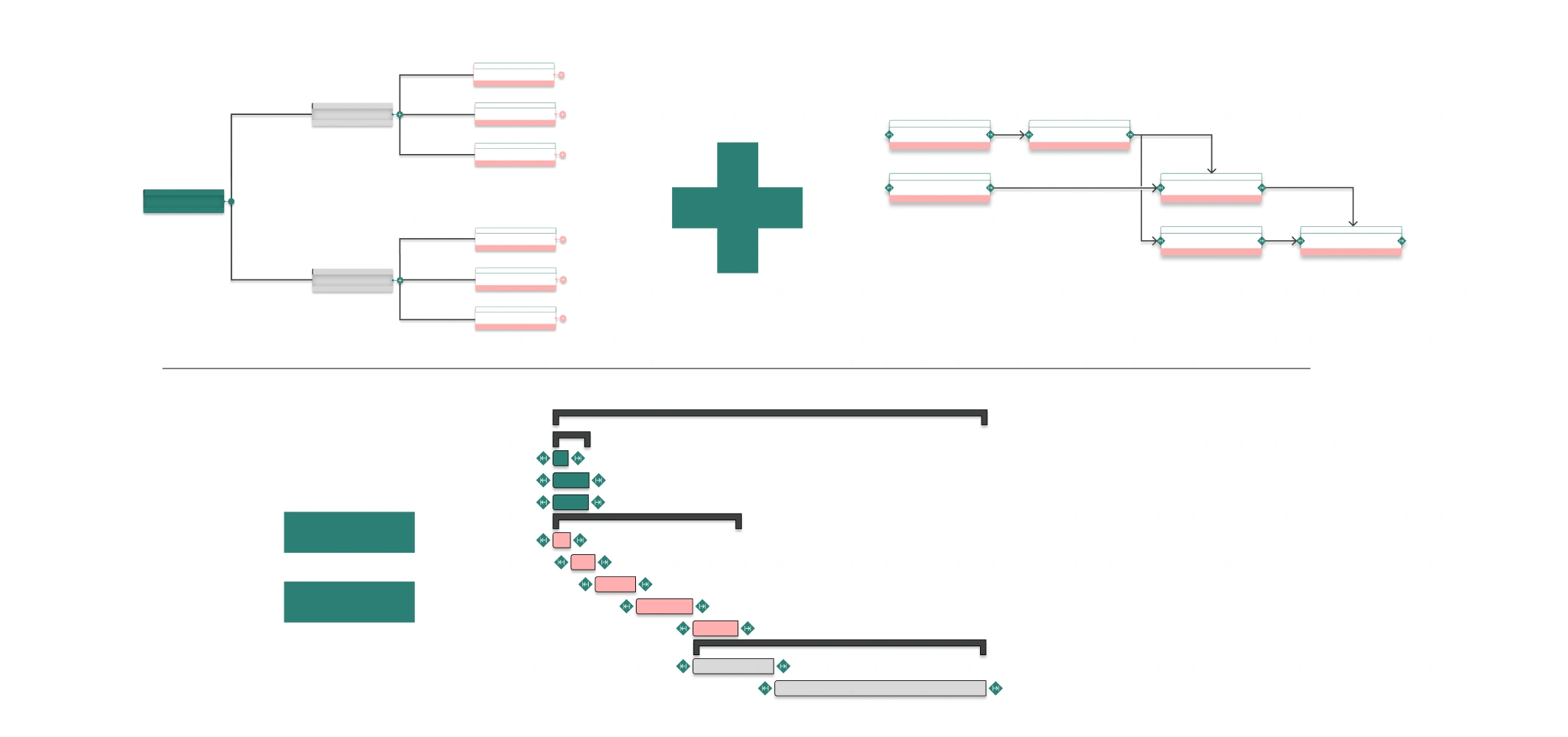The Gantt Chart, the Ultimate Tracking Tool… Really?
Estimated reading time : 5 minThe Promise of the Gantt Chart
The Gantt chart is one of the most effective and most commonly used tracking tools in project management.
Ideal for visually representing the schedule and task progress, it provides an instant read of the project’s dynamics.
Its promise is simple: offer a clear view of how a project unfolds over time.
How Is a Gantt Chart Structured?
Generally, a Gantt chart consists of two distinct parts: a left side and a right side.
The left side mirrors the project’s WBS (Work Breakdown Structure). It lists all tasks to be performed: elementary tasks as well as parent tasks that group several subtasks.
The right side shows each task as a time bar. The bar’s length indicates the planned duration, and you can also visualize task dependency links and sometimes resource assignments.
At a glance, you can see:
- what’s planned
- when each task starts and ends
- what’s in progress
- what’s late or ahead of schedule.

What Is a Gantt Chart For?
A Gantt chart helps to:
- Communicate with teams around a shared schedule
- Reassure stakeholders by presenting a clear roadmap
- Visualize task dependencies and potential bottlenecks
- Identify the project’s key milestones over time
It is therefore a particularly powerful visualization and communication tool.
For operational teams, when built down to the task level, the Gantt becomes a true day-to-day tracking tool, provided it’s updated regularly.
For project managers, it’s a compass that helps anticipate slippages and make informed decisions.
For leadership, it can be adapted to a deliverable- or objective-based view, giving a more synthetic, high-level perspective that’s ideal for strategic reporting.
The Methodological Foundations of the Gantt Chart
A Gantt chart is the combined result of two fundamental steps in building a project:
- structuring, achieved through the WBS (Work Breakdown Structure),
- sequencing, performed using the PERT diagram.
The WBS enables you to build the Gantt’s left-hand side intelligently by defining the right level of detail for both overall management and operational execution. It also ensures no task is forgotten.
The PERT diagram, for its part, links tasks together by defining logical dependencies. It ensures the Gantt is dynamic and not just a static snapshot of the project at a given moment.
When dependencies are properly defined, any change (duration, start date, delay…) is automatically propagated through the Gantt.
Built this way, the Gantt chart becomes:
- a flexible tool, adjustable when unforeseen events occur
- a reliable reporting tool, useful throughout the project—from launch to closure.

The Limits of the Gantt Chart
The main weaknesses of the Gantt chart don’t come from the tool itself, but from the way it’s used—or rather misused.
Very often, a Gantt is requested at the very beginning by management teams, then handed to project managers who, under the influence of poor tools or habits, build it without any method.
Indeed, many companies and software tools have skipped foundational methods like WBS and the PERT diagram in favor of building directly in a Gantt chart. This may seem simpler at first, but that simplicity is deceptive.
A Gantt is easy to read but hard to build well without relying on a rigorous method. It requires mastering, in parallel:
- logical structuring (WBS),
- dependency-based sequencing (PERT),
in a tool that often facilitates neither.
The result: due to lack of time or project management skills, many schedules are thrown together hastily, with little coherence or rigor.
The consequences are numerous:
- tracking that’s hard to maintain
- Gantts that become obsolete quickly
- poorly anticipated risks
- unrealistic announced deadlines
- overloaded, pressured teams.
The Gantt chart is not a magic tool. Without method, it becomes an illusion of control.
Automatically Build Your Gantt Chart with Orchesia
As you’ve gathered, at Orchesia, we’re convinced that an organization without the means or dedicated project management resources is heading for trouble if it builds its project directly as a Gantt chart.
Tools like Monday, Asana, ClickUp, TeamGantt, and others put the project manager in front of an empty chart to build from scratch. The risk? Launching into a shaky plan with no structure or method.
That is precisely why Orchesia exists.
Our mission: support every project manager—even a beginner—with software that respects the method while automatically generating the right tracking tool (Gantt or otherwise).
Concretely, when you log in, you won’t be facing an empty Gantt, but rather two project-building tabs:
- A mind map tab, a visual take on the WBS method
- A dependencies tab, an intuitive take on the PERT diagram.
These two tools are visual, simple, and interconnected: they gather all the information needed to automatically generate a Gantt chart.
A flexible, modular, living chart—a true reflection of the project—at every stage of its evolution.
Try our project management software Orchesia free for two weeks, no commitment!